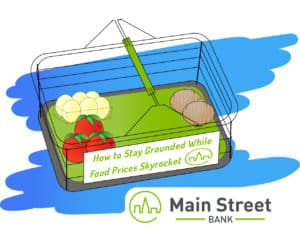If you have been to a grocery store over the past year, then you have likely noticed that groceries are more expensive than previous years. And you aren’t wrong. Due to a variety of economic factors, the average grocery prices for consumers have risen significantly, outpacing the historic average of year-over-year prices increases. Rising costs of groceries, combined with rising rent and other expenses, can make it difficult to spend in moderation. In this article we’ll be sharing some of the ways that we have learned to keep our grocery bills manageable through the recent price increases.
Follow us on Facebook for more savings tips!
Eat Less Meat
Some of the largest price increases are for meat, seafood, and eggs. According to the USDA, eggs this year are about 40% more expensive than last year, mainly due to a type of influenza that is affecting millions of chickens in the US. Meat and seafood prices have also risen for a variety of reasons. A great way to reduce your grocery bill is to buy less of these expensive items. Try to substitute your protein consumption with alternatives like tofu, beans, and protein rich vegetables like broccoli. When buying meat, you can save money by buying the less expensive cuts or purchasing in bulk and freezing portions for later. Checking the price-per-pound is a good way to hunt for deals, helping you compare the cost of goods even when the portion sizes vary.
Create a Shopping Plan
Creating a plan for your grocery trips helps bring consistency into your grocery routine. This can help you solve some of the common unknowns, like how much food your family eats each week and how much it typically costs. Knowing this can help you avoid buying too much at once and wasting expensive groceries. Try designating a day each week for your grocery trips so that you are always shopping for the same number of days at a time.
Preparing for your grocery trips in advance helps you spend less once you’re there. You can prepare by counting the meals you’ll need to shop for and creating a grocery list with those essential ingredients. You can do the same thing for snacks and pantry items. Although snacks are less important than meals, it can help to figure out how frequently you go through them and budget accordingly.
Organizing your grocery list in the order that you travel through the grocery store is a good way to avoid missing things you need. Paper and pen are a classic way to tackle the grocery list, but we are also fans of Apple’s Reminders app for grocery shopping.
Follow a Grocery Budget
Setting up a budget for your grocery shopping is a surefire way to save money at the store. You can set it up so that you are spending a comfortable and consistent dollar amount on your weekly groceries. Holding yourself accountable to a specific budget for the week is the first level of grocery budgeting. If you are looking for some help starting to build a budget for yourself, you can check out our comprehensive budgeting guide that teaches you how to thrive with a budget.
Eat Out Less
Restaurant meals can get expensive. Cutting back on eating out is a good place to start when you’re trying to reduce your spending on food. Sometimes even just a single meal at a restaurant can cost you more than several homecooked meals. Preparing larger meals and eating leftovers for a few days can help stretch your dollars, as well as keeping cooking time at a minimum. Cooking at home can be intimidating, but it’s a useful skill to develop.
Reduce Spending on Nonessential Foods
When we shop for groceries, we often pick up items that we don’t really need simply because we are used to buying them. Food and drink based on alcohol, caffeine, or sugar are usually nonessential items that can be consumed less. Limiting spending around these categories of food can help trim down unnecessary grocery expenses. While we’re not suggesting that you quit coffee just like that (as if it were that easy!) there may be more affordable ways to get your caffeine fix. Making coffee at home is much less expensive than visiting a coffee shop. An easy way to control this kind of spending is the “one treat” rule: Each time you go grocery shopping, pick one thing that will be your treat for the trip. That way you can satisfy yourself while still prioritizing the food that you need.
Additional Tips
- Buy items on sale. Many grocery stores put a lower clearance price on overstocked items. You can often take advantage of this when shopping to stock your pantry when your essentials go on sale.
- Clip coupons. Clipping coupons is a time-tested way to hunt for some of the best deals. Try saving the coupons from the newspaper, or from your last grocery receipt.
- Stockpile non-perishable items. If you get a good price for a non-perishable item, including canned goods, flour, dried pasta, it’s a good idea to stock up.
- Buy items at dollar stores. You don’t have to buy everything you need at grocery stores. There are some items, including plastic bags and cleaning products, that are cheaper at dollar stores.
- Avoid expensive brands. We all have brands we love. And if you find a good sale or have coupons for those brands, you can still enjoy them. But if you don’t have a specific brand preference and can get another brand cheaper, try it out and see if it’s comparable. This is a good way to save a few dollars every time you go out to shop.
- Eat leftovers. One smart way to save money at the grocery store is to stay out of it. An easy way to accomplish that is to stretch your meals by eating leftovers.
- Leave your hunger at home. One of the biggest mistakes you can make is shop when you’re hungry. If you grocery shop while hungry, your stomach will make all the choices for you and you’ll end up spending more than you planned.
- Sign up for rewards cards. It usually only takes a few minutes to sign up for grocery store loyalty or rewards cards, but in the long term, you can enjoy significant savings when you shop with them.
Get ready to save today.
With these tips under your belt, you’re ready to start planning for your next shopping adventure today. You’ll be amazed how quickly the savings will add up.
Would you like to receive more information from us? Sign up for our email newsletter to get the latest news, announcements, and information from Main Street Bank.


